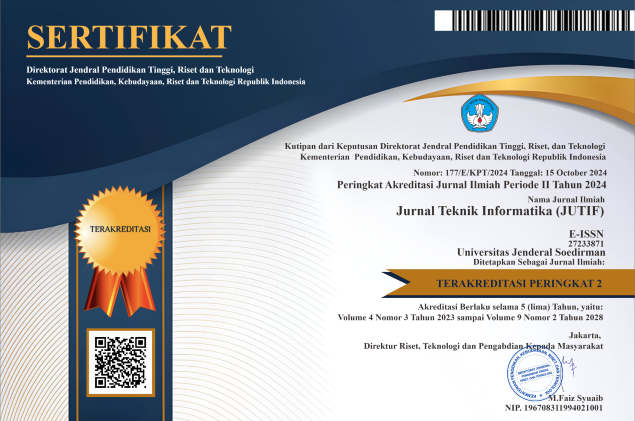Hybrid Time-Series Approaches for PV Power Prediction: Evaluating SARIMAX and Generative Model
DOI:
https://doi.org/10.52436/1.jutif.2025.6.4.4955Keywords:
Missing data, SARIMAX, Solar energy forecasting, Time-series cross validation, WGAN-GPAbstract
Forecasting the output power of photovoltaic (PV) systems is crucial in managing renewable energy efficiently and sustainably. The availability of historical data and environmental variables, such as temperature and humidity, greatly influences prediction accuracy. However, in practice, historical data is often incomplete due to technical constraints or limited monitoring infrastructure, which results in decreased prediction quality and system efficiency. To overcome these challenges, this study proposed a comparative approach between two predictive models, namely SARIMAX (Seasonal AutoRegressive Integrated Moving Average with eXogenous variables) as a classical statistical model, and WGAN-GP (Wasserstein Generative Adversarial Network with Gradient Penalty) as a generative deep learning model designed to handle incomplete data and capture nonlinear relationships. The datasets included PV power output from the monitoring system at Universitas Kristen Immanuel (UKRIM) Yogyakarta, along with temperature and humidity data from the Kalitirto weather station in Sleman, Yogyakarta. The research was conducted through several stages, namely: data collection, pre-processing, model training, and evaluation using MAE, MSE, RMSE, and MAPE metrics. The results show that the SARIMAX model using the Time-Series Cross-Validation (TSCV) achieves the best numerical performance (MAE = 0.085; RMSE = 0.145). However, this model fails to represent daily patterns realistically. In contrast, both the standard SARIMAX and WGAN-GP models are more consistent in representing seasonal patterns and daily fluctuations, even though their prediction errors were slightly higher in terms of numerical metrics. The findings advance scientific understanding of hybrid forecasting models and offer practical implications for improving energy reliability and decision-making in data-constrained environments.
Downloads
References
R. R. Urs, A. Chadly, O. Mussawar, M. Wei, and A. Mayyas, “Powering towards cleaner urban Energy: Integrating PV, reversible fuel cells, and batteries,” Renew. Energy, vol. 254, no. December 2024, p. 123662, 2025, doi: 10.1016/j.renene.2025.123662.
S. Kataria and A. Sikander, “A new framework for PV array performance enhancement under non-uniform irradiance,” Electr. Power Syst. Res., vol. 248, no. May, p. 111897, 2025, doi: 10.1016/j.epsr.2025.111897.
M. Jbene, R. Saadane, S. Tigani, and A. Chehri, “Personalized PV system recommendation for enhanced solar energy harvesting using deep learning and collaborative filtering,” Sustain. Energy Technol. Assessments, vol. 60, no. November, p. 103563, 2023, doi: 10.1016/j.seta.2023.103563.
S. Al-Dahidi, M. Alrbai, B. Rinchi, L. Al-Ghussain, O. Ayadi, and A. Alahmer, “A tiered NARX model for forecasting day-ahead energy production in distributed solar PV systems,” Clean. Eng. Technol., vol. 23, no. October, p. 100831, 2024, doi: 10.1016/j.clet.2024.100831.
S. Al-Dahidi et al., “Techno-economic implications and cost of forecasting errors in solar PV power production using optimized deep learning models,” Energy, vol. 323, no. December 2024, p. 135877, 2025, doi: 10.1016/j.energy.2025.135877.
E. G. Kim, M. S. Akhtar, and O. B. Yang, “Designing solar power generation output forecasting methods using time series algorithms,” Electr. Power Syst. Res., vol. 216, no. July 2022, p. 109073, 2023, doi: 10.1016/j.epsr.2022.109073.
I. A. Kachalla, C. Ghiaus, A. Ademuwagun, O. B. Odeyinde, and M. Baseer, “Data-driven hybrid SARIMAX-MLP framework for energy consumption prediction in residential micro-grid,” Results Eng., vol. 26, no. May, p. 105336, 2025, doi: 10.1016/j.rineng.2025.105336.
N. Sultana, “Balancing Accuracy and Efficiency in Multi-Step Building-Level Electric Load Forecasting: Deep Learning vs. Classical Time-Series Models,” Energy Built Environ., 2025, doi: 10.1016/j.enbenv.2025.05.012.
H. Abuzaid, M. Awad, A. Shamayleh, and H. Alshraideh, “Predictive modeling of photovoltaic system cleaning schedules using machine learning techniques,” Renew. Energy, vol. 239, no. December 2024, p. 122149, 2025, doi: 10.1016/j.renene.2024.122149.
S. A. Haider, M. Sajid, H. Sajid, E. Uddin, and Y. Ayaz, “Deep learning and statistical methods for short- and long-term solar irradiance forecasting for Islamabad,” Renew. Energy, vol. 198, no. May 2022, pp. 51–60, 2022, doi: 10.1016/j.renene.2022.07.136.
J. Lee and Y. Cho, “National-scale electricity peak load forecasting: Traditional, machine learning, or hybrid model?,” Energy, vol. 239, p. 122366, 2022, doi: 10.1016/j.energy.2021.122366.
L. Wencheng and M. Zhizhong, “Prediction of rainy-day photovoltaic power generation based on Generative Adversarial Networks and enhanced Sparrow Search Algorithm,” Comput. Electr. Eng., vol. 119, no. PA, p. 109529, 2024, doi: 10.1016/j.compeleceng.2024.109529.
S. Park, J. Moon, and E. Hwang, “Data generation scheme for photovoltaic power forecasting using Wasserstein GAN with gradient penalty combined with autoencoder and regression models,” Expert Syst. Appl., vol. 257, no. August, p. 125012, 2024, doi: 10.1016/j.eswa.2024.125012.
W. Wang, J. Yang, Y. Li, G. Ren, and K. Li, “Data-driven deep learning model for short-term wind power prediction assisted with WGAN-GP data preprocessing,” Expert Syst. Appl., vol. 275, no. November 2024, p. 127068, 2025, doi: 10.1016/j.eswa.2025.127068.
M. Yang, Y. Guo, T. Huang, and W. Zhang, “Power prediction considering NWP wind speed error tolerability: A strategy to improve the accuracy of short-term wind power prediction under wind speed offset scenarios,” Appl. Energy, vol. 377, no. PD, p. 124720, 2025, doi: 10.1016/j.apenergy.2024.124720.
L. Huang, L. Li, X. Wei, and D. Zhang, “Short-term prediction of wind power based on BiLSTM–CNN–WGAN-GP,” Soft Comput., vol. 26, no. 20, pp. 10607–10621, 2022, doi: 10.1007/s00500-021-06725-x.
A. Ait Mansour, A. Tilioua, and M. Touzani, “Bi-LSTM, GRU and 1D-CNN models for short-term photovoltaic panel efficiency forecasting case amorphous silicon grid-connected PV system,” Results Eng., vol. 21, no. December 2023, p. 101886, 2024, doi: 10.1016/j.rineng.2024.101886.
X. Gu, K. W. See, Y. Liu, B. Arshad, L. Zhao, and Y. Wang, “A time-series Wasserstein GAN method for state-of-charge estimation of lithium-ion batteries,” J. Power Sources, vol. 581, no. August, p. 233472, 2023, doi: 10.1016/j.jpowsour.2023.233472.
M. Yusuf Demirci, N. Beşli, and A. Gümüşçü, “An improved hybrid solar cell defect detection approach using Generative Adversarial Networks and weighted classification,” Expert Syst. Appl., vol. 252, no. May, 2024, doi: 10.1016/j.eswa.2024.124230.
D. Cui et al., “Rotor fault diagnosis of centrifugal pumps in nuclear power plants based on CWGAN-GP-CNN for imbalanced dataset,” Prog. Nucl. Energy, vol. 178, no. March 2024, p. 105500, 2025, doi: 10.1016/j.pnucene.2024.105500.
S. Khan, Y. Muhammad, I. Jadoon, S. E. Awan, and M. A. Z. Raja, “Leveraging LSTM-SMI and ARIMA architecture for robust wind power plant forecasting,” Appl. Soft Comput., vol. 170, no. December 2024, p. 112765, 2025, doi: 10.1016/j.asoc.2025.112765.
G. Flood-Page, L. Boutonnier, and J. M. Pereira, “Application of the Akaike Information Criterion to the interpretation of bender element tests,” Soil Dyn. Earthq. Eng., vol. 177, no. November 2023, p. 108373, 2024, doi: 10.1016/j.soildyn.2023.108373.
S. yeon Lee, L. yeong Choi, J. Park, S. woon Hong, J. Park, and M. woong Jung, “Time-series validation of AERMOD using atmospheric ammonia data from an intensive livestock-rearing region in Korea,” Comput. Electron. Agric., vol. 223, no. May, p. 109109, 2024, doi: 10.1016/j.compag.2024.109109.
J. Li, F. Li, K. Sun, and B. Sun, “Bi-level coordinated expansion planning of high-PV-penetration active distribution networks incorporating multiple flexible resources considering WGAN-GP-based uncertainty generation,” Energy, vol. 330, no. May, p. 136685, 2025, doi: 10.1016/j.energy.2025.136685.
A. Saranj and M. Zolfaghari, “The electricity consumption forecast: Adopting a hybrid approach by deep learning and ARIMAX-GARCH models,” Energy Reports, vol. 8, pp. 7657–7679, 2022, doi: 10.1016/j.egyr.2022.06.007.
Additional Files
Published
How to Cite
Issue
Section
License
Copyright (c) 2025 Sunneng Sandino Berutu, Immanuel Richie De Harjo Zakaria, Anita Yuan, Mosiur Rahman

This work is licensed under a Creative Commons Attribution 4.0 International License.



























